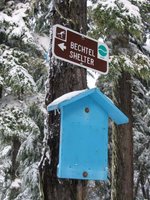 This photo was taken in 1979, as we are ready to depart for Alaska. It is a photo of Carol, Roy and mother, Elia, in front of the 1972 Cabana motor home. The motor home has recorded over 200,000 miles while on our way to Yakima (see earlier blog). Trivia: Roy's mother is eight years younger in the photo than Roy is NOW!
This photo was taken in 1979, as we are ready to depart for Alaska. It is a photo of Carol, Roy and mother, Elia, in front of the 1972 Cabana motor home. The motor home has recorded over 200,000 miles while on our way to Yakima (see earlier blog). Trivia: Roy's mother is eight years younger in the photo than Roy is NOW!
After 34 years, the step for entering and exiting the motor home rusted "a little!" It was MORE than ready for replacement. Instead of using a similar step, which is still manufactured, I decided to construct a longer lasting step.
 The metal step rusted because I covered it decades ago with a carpeted board to increase the step area for Carol. This combination of carpet and wood retained moisture through the decades to accelerate rusting.
The metal step rusted because I covered it decades ago with a carpeted board to increase the step area for Carol. This combination of carpet and wood retained moisture through the decades to accelerate rusting.
I cut the new step out of heavier gauge metal. This step will last many times longer than the original step.

To slow the process of rusting, I applied two coats of high-temperature paint.
 After applying contact cement to the new step, I glued a carpet to it's surface and placed six clamps to insure bonding. (Trivia: Due to laying down a new carpet in the school, this carpet was removed from the classroom in which I taught for ten years from 1969 - 1979. It had been trod upon by thousands of students and this teacher for many miles!)
After applying contact cement to the new step, I glued a carpet to it's surface and placed six clamps to insure bonding. (Trivia: Due to laying down a new carpet in the school, this carpet was removed from the classroom in which I taught for ten years from 1969 - 1979. It had been trod upon by thousands of students and this teacher for many miles!)
Though the factory installed step was riveted on, I used bolts this time so the step could be easily removed and repaired as needed. Since the steel plate is heavier than the original metal, it should last 40 years!














































